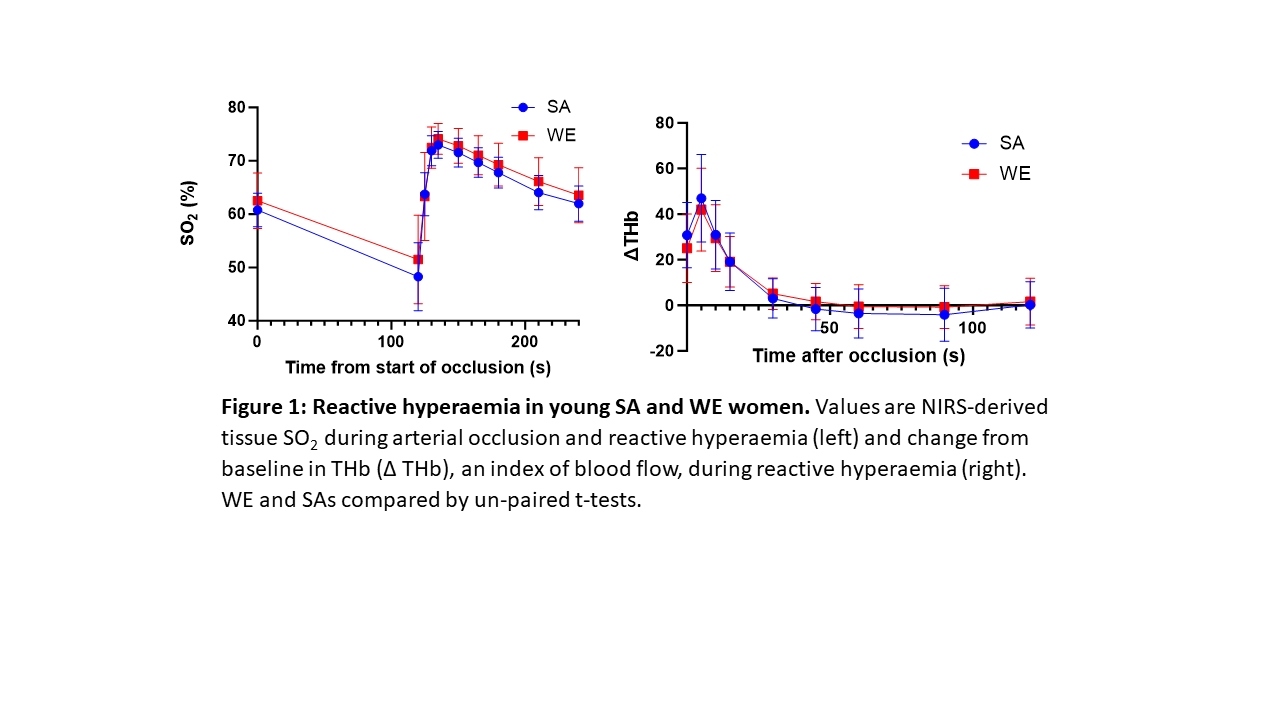Cardiovascular disease (CVD) prevalence is greater in those of South Asian (SA) ethnicity than White Europeans (WE), SA women being at particular risk of early ischaemic heart disease (1,2). Correspondingly, we showed in university students, that endothelium-dependent dilatation (EDD), a prognostic indicator of CVD (3) is blunted in young SA, relative to WE women; SA women also had lower physical activity levels and fruit/vegetable intake (4), which are risk factors for CVD. University students generally have unhealthy eating habits: only ~18% of UK students meet the UK recommended daily allowance (RDA) of 5 fruit/vegetable portions/day (5). We have now tested the effect of transition to university on 1st year students recruited to an intervention study, in which we will test the effects of improving the diet.
Female students (24 SA; 21 WE), aged 18.75±1.03, 19.00±1.14 years respectively (mean±SD), who volunteered for the intervention study, completed the EPIC food frequency, International Physical Activity questionnaires (FFQ, IPAQ respectively) and Perceived Stress Scale questionnaire at the beginning of semester 1. In addition, near infrared spectroscopy was applied to forearm to monitor total haemoglobin (THb), an index of blood flow, and oxygen saturation (SO2) in muscle during and following 2-min arterial occlusion (reactive hyperaemia), which reflects EDD. Participants repeated all 3 questionnaires at the end of Semester 1.
There were no differences between WE and SA women for BMI (22.25±3.25 vs 21.96±4.80; mean±SD) or mean arterial blood pressure (77.05±18.50 vs 71.19±12.80mmHg) (P=0.81, 0.22 respectively, un-paired t-test). In contrast to our recent findings (1), there were also no differences between WE and SA women for peak reactive hyperaemia or tissue SO2 (Figure 1). Further, there were no differences between WEs and SAs for IPAQ (2745±1968 vs 3220±2369 MET min/week; P=0.47), fruit/vegetable (2.40±1.35 vs 2.35±1.5 portions/day; P=0.92) or vitamin C (111.6±57.94 vs 101.1±54.93 mg/day; P=0.54).
Finally, when WEs and SAs were grouped together, there were no differences between the beginning and end of Semester 1 for IPAQ (2998±2180 vs 2377±1607 MET min/week; P=0.12; paired t-test) or Perceived Stress scores (18.18±6.24 vs 19.40±6.44; P= 0.12), both being in the moderate range. Fruit/vegetable intake did not change (2.37±1.42 vs 2.55±1.63 portions/day; p=0.58). However, total energy (1823±679.3 vs 1466±567.3 kcal/day; P=0.006), carbohydrate (221.0±85.62 vs 175.0±71.70g/day; P=0.007), Vitamin C (106.0±55.96 vs 79.15±55.72mg/day; (P=0.02) and fibre (16.93±9.30 vs 12.98±7.61g/day; P=0.04) decreased by the end of semester 1, to below the RDA, protein decreasing from (81.83±36.01 vs 64.99±26.56g/day; P=0.006).
We suggest that the present finding that physical activity, dietary intake and indices of EDD did not differ between young WE and SA women on entry to university, may be explained if WE women with poorer lifestyle choices self-selected for a dietary “improving” intervention study. If so, then the blunted EDD reported in young SA relative to WE women (2) may partly reflect lifestyle choices of SA women rather than genetics. Irrespective, the present findings indicate that the diet of WE and SA female students who already have a poor diet on entry to university deteriorates during transition to university and requires attention.

